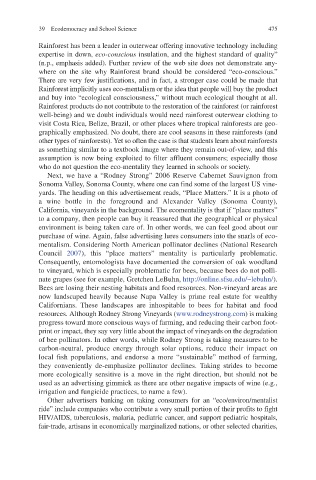Page 500 - Cultural Studies of Science Education
P. 500
39 Ecodemocracy and School Science 475
Rainforest has been a leader in outerwear offering innovative technology including
expertise in down, eco-conscious insulation, and the highest standard of quality”
(n.p., emphasis added). Further review of the web site does not demonstrate any-
where on the site why Rainforest brand should be considered “eco-conscious.”
There are very few justifications, and in fact, a stronger case could be made that
Rainforest implicitly uses eco-mentalism or the idea that people will buy the product
and buy into “ecological consciousness,” without much ecological thought at all.
Rainforest products do not contribute to the restoration of the rainforest (or rainforest
well-being) and we doubt individuals would need rainforest outerwear clothing to
visit Costa Rica, Belize, Brazil, or other places where tropical rainforests are geo-
graphically emphasized. No doubt, there are cool seasons in these rainforests (and
other types of rainforests). Yet so often the case is that students learn about rainforests
as something similar to a textbook image where they remain out-of-view, and this
assumption is now being exploited to filter affluent consumers; especially those
who do not question the eco-mentality they learned in schools or society.
Next, we have a “Rodney Strong” 2006 Reserve Cabernet Sauvignon from
Sonoma Valley, Sonoma County, where one can find some of the largest US vine-
yards. The heading on this advertisement reads, “Place Matters.” It is a photo of
a wine bottle in the foreground and Alexander Valley (Sonoma County),
California, vineyards in the background. The ecomentality is that if “place matters”
to a company, then people can buy it reassured that the geographical or physical
environment is being taken care of. In other words, we can feel good about our
purchase of wine. Again, false advertising lures consumers into the snarls of eco-
mentalism. Considering North American pollinator declines (National Research
Council 2007), this “place matters” mentality is particularly problematic.
Consequently, entomologists have documented the conversion of oak woodland
to vineyard, which is especially problematic for bees, because bees do not polli-
nate grapes (see for example, Gretchen LeBuhn, http://online.sfsu.edu/~lebuhn/).
Bees are losing their nesting habitats and food resources. Non-vineyard areas are
now landscaped heavily because Napa Valley is prime real estate for wealthy
Californians. These landscapes are inhospitable to bees for habitat and food
resources. Although Rodney Strong Vineyards (www.rodneystrong.com) is making
progress toward more conscious ways of farming, and reducing their carbon foot-
print or impact, they say very little about the impact of vineyards on the degradation
of bee pollinators. In other words, while Rodney Strong is taking measures to be
carbon-neutral, produce energy through solar options, reduce their impact on
local fish populations, and endorse a more “sustainable” method of farming,
they conveniently de-emphasize pollinator declines. Taking strides to become
more ecologically sensitive is a move in the right direction, but should not be
used as an advertising gimmick as there are other negative impacts of wine (e.g.,
irrigation and fungicide practices, to name a few).
Other advertisers banking on taking consumers for an “eco/environ/mentalist
ride” include companies who contribute a very small portion of their profits to fight
HIV/AIDS, tuberculosis, malaria, pediatric cancer, and support pediatric hospitals,
fair-trade, artisans in economically marginalized nations, or other selected charities,

